Save The Vinegar For Your Chips. How to refresh your antiques using natural methods?
written by Valerie Hammond
Everything old is new again and that brings new meaning to the term “recycling”. We all have “bits and pieces” purchased, given by family or friends, and all things bright and beautiful aren't always as clean and shiny as they could be. As the holiday season approaches, and we prepare to entertain family and friends, it's the perfect time to polish and shine items which have lost their gleam. Read further and learn the best methods to keep your antiques nice and fresh using natural products.
Art deco tea service in sterling silver. Image: Public Domain
Treasures improperly stored may need more than simple dusting. If your silver candlesticks now look like ebony, and your antique tablecloth now has more spots than a leopard, there are many ways to clean them. Today, however, we are all trying to be ecologically minded and to reduce the chemical based products we use . Environmentally friendly cleaning or “green “ products are available and, for the most part, work well. Whether it's an heirloom, or a past purchase, these items deserve to be treated lovingly and it is often the case that cleaning improperly can pose more damage to them than not cleaning at all.
We thought it would be fun to share some cleaning suggestions with you.
If you remember when hacking meant chopping something up then you may have tried some of these remedies over the years. Today a “hack” means a tip or shortcut. Shortcuts don't always “hack it“ as I found out when trying some. Some of these suggestions sound more like recipes than cleaning hints.
Do you wonder what value your treasures may hold? Submit them for appraisal here and find out!
Related: If all that glitters isn't gold, could it be Silver? Sterling silver - Collectible or commodity?
"Treasures improperly stored may need more than simple dusting. If your silver candlesticks now look like ebony, and your antique tablecloth now has more spots than a leopard, there are many ways to clean them. "
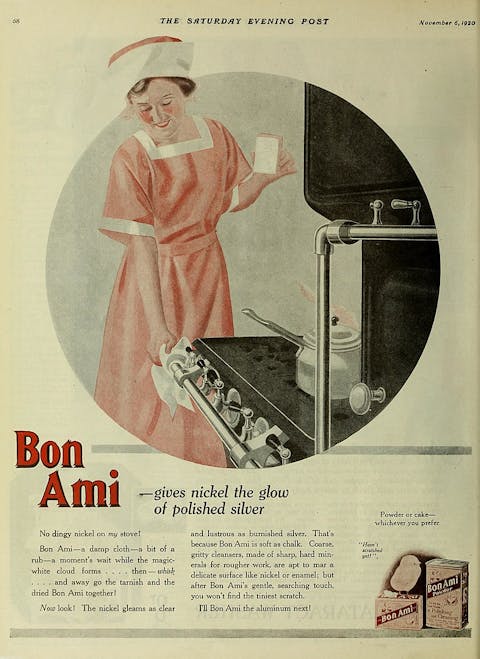
Advertisement for nickel tarnish remedy "Bon Ami", The Saturday evening post (1920). Image: Public Domain
True of False: Should it Shine Like a New Penny?
Nothing gleams the way new copper and brass does. However it does change over time . The immediate reaction is to polish it to make it look new again. If you have copper or brass items, simply wash them with a mild liquid detergent (not lemon scented or in a dishwasher) and warm water and dry thoroughly. The trick is to remove the surface grime, without destroying that warm tone or patina which has taken years to acquire.
One tried and true, (which will polish if you can't bear the tarnish) is tomato juice. Apply with a soft damp cloth, until the patina (tarnish) is removed, and rinse in clear tepid water. Ketchup also works, but it is dense and a bit sticky and can be difficult to rinse off without using detergent. Other tomato based products do clean both metals. Fresh tomatoes however did nothing to the tarnish. I decided that I prefer my tomato paste in a pasta sauce and my juice in a glass with a celery stick .
Then I tried a salt, vinegar and flour paste, which actually did remove the tarnish, but smelled dreadful when applied, and despite repeated scrubbing, the smell stayed on my hands for days. The mixture was abrasive, so it had more of a sanding than polishing effect and required repeated washings in order to remove the smell from the metal.

A pair of George III Paktong brass candlesticks with visible tarnish. Image: Bonhams
"Nothing gleams the way new copper and brass does. However it does change over time . The immediate reaction is to polish it to make it look new again."
Conclusion: Leave the salt and vinegar for your fish and chips. My personal opinion as a dealer and appraiser is that if it is not silver, don't polish. It took years for silver to acquire that warm rich finish and removing it will strip it of its history and age. Wash it to remove surface grime dry and then display it again. That's as environmentally friendly as you can be.
Related: How to value Silverware?
True of False: Every Silver Lining Has a Cloud.
There has been a reduction in the demand for sterling and silver plates since the New Millenium. Trends have changed, and flatware and holloware has now been replaced with more convenient low maintenance items.
In “Downton Abbey”, the staff were forever polishing silver. In fact during the Victorian era there was a syndrome referred to as “butlers thumb“, a discomfort of the thumb joint and calluses caused by buffing and polishing with the bare hand.
Nothing looks as elegant as a well set table, with a fine tablecloth and napkins, sparkling glasses and fine china. Today that type of daily formal dining is all but gone or reserved for special occasions. If you do have to dig out the family silver to set your dinner table, it will probably need some help .
There are numerous methods for “easy ways to clean your silver” and a well known search engine offers over 435,000,000 searches. It Googled my mind!
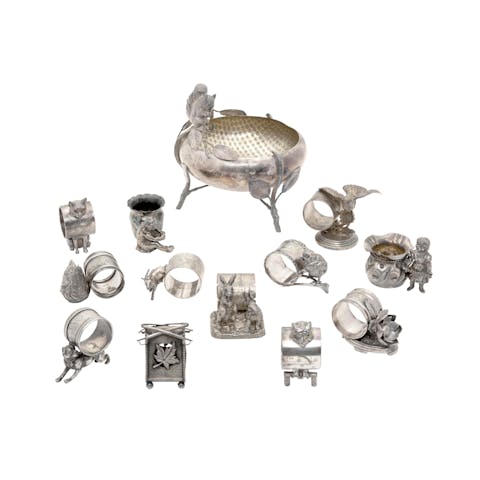
American silver-plated figural napkin holders. Image: Bonhams
Some recommend the tin foil, bicarbonate of soda, warm water bath, especially for silver with intricate raised patterns. However, it is a caustic process which eats off the top layer revealing the brighter surface below (it works more as an exfoliation than polishing). As a dealer, I do not recommend silver dips either. They work, but I'm not thrilled about the process.
Can you green clean silver? It is a good question. I first tried a chalk and water paste.The scrubbing action of the gritty paste worked on a ladle, but it was more of a physical than chemical reaction since there is no real active ingredient in this one. It is not bad and you can apply it with bare hands but if the silver plate is already worn, it can scuff the surface. Some cleaning “gurus” swear by toothpaste, and I must say it worked better than the chalk. It didn't help with embossed items though, leaving the tarnish, but minty fresh flatware. One suggestion was a pencil eraser but it's a tedious process.
Related: How to Value Metals & Brassware
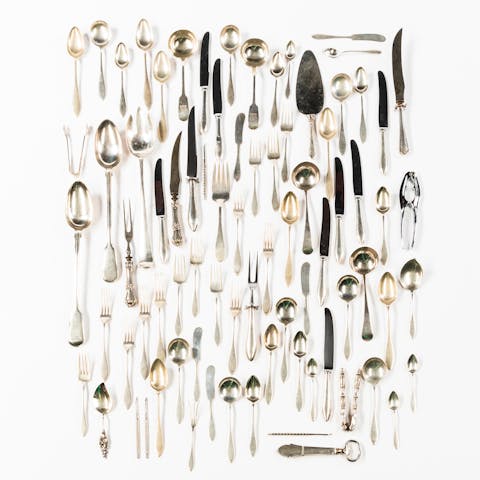
Group of Sterling Silver and Silver-plated Flatware. Image: Bonhams
Conclusion: None of these methods were great. The best way to keep silver (plated or sterling,) is to clean it often, with as mild a polish as possible. Plant based glass cleaner, or washing up liquid will work on lightly tarnished items. Abrasive cleaners scuff the surface of your silver, like skates on ice. To make your silverware shiny for longer, store it in paper bags, and don’t ever use plastic bags or wrap or wear rubber gloves when you handle it. All those materials promote tarnish (hence the white gloves in “Downton Abbey”). Avoid silver dips and scouring pads.
Silver is elegant and beautiful, but every silver lining has a cloud, the cloud here is ,it must be polished…
True of False: Sick Means Cool or Excellent.
Not always! When it comes to glass and crystal, the term sick is used to describe cloudy looking glass. That cannot be removed because the damage is in the glass, not on the surface. Surface scratches can be smoothed with tooth polish on a soft cloth, but it takes a lot of effort and is only for scratches.
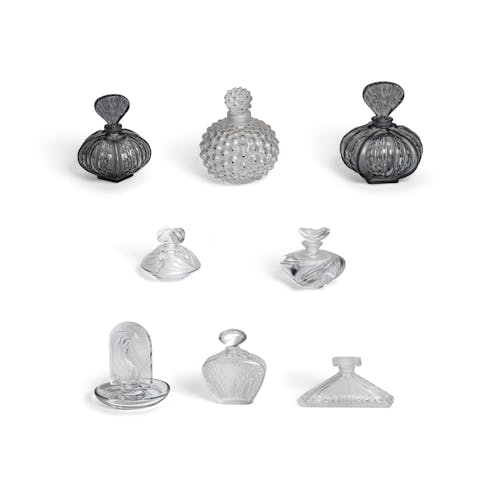
A group of Lalique glass perfume bottles and accessories. Image: Bonhams
Lime deposit is common in vases. Some of the most effective remedies were inexpensive and successful. I tried this on a Victorian vase and a cut glass bowl:
1 tbsp of white vinegar
1 quart of water.
Swish vigorously, rinse with clear water. Excellent result!
Narrow necks and bases are tricky. Grime trapped inside looks unsightly but is difficult to clean with a cloth or brush. Denture tablets worked, but only with repeated use. The fizzing action is the key.
A dryer sheet and hot water “hack” supposedly absorbs the grime with the water . It absorbed the water and left a waxy residue in the glass which had to be cleaned!

A pair of mid 19th century French gilt bronze mounted and celadon green opaline glass vases. Image: Bonhams
Next remedy required ⅓ cup of rice or dry lentils, 1/3 cup of baking soda and water, shaken well. In a slender hollow candle holder, it did remove a lot of the grime, but it needed 2 attempts. Larger beans worked well in a wider vase.
Cola and beans? Really? We know what Cola does to pennies. The ingredients and fizz in the cola and the scrubbing motion of the beans scoured quite well. If it doesn't work for you, just relax and finish the cola!
There are excellent plant based cleaners available and some liquid detergents work well for light grime. However, cleaners that contain citric acid as a grease cutting agent can be harsh on older glass.
Conclusion: Surprisingly, Both the cola beans and rice, and the denture cleaner worked
True or False: When In Doubt Bleach It Out!
China and ceramics become stained, cracked and crazed over time (those tiny little lines) . Crazing is in the glaze surface and often noticeable.I don’t recommend bleach to fix that .
Bleach is fine for bathrooms, but not for your fine china and porcelain and never for food service items. It seeps into crevices, bleaches the area around the compromised glaze, and can make damage look worse. The smell lasts for ages.
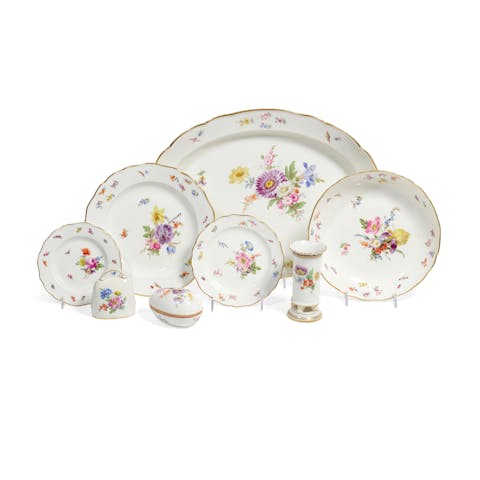
A Meissen Deutsche Blumen Pattern porcelain dinner service. Image: Bonhams
I experimented with 3 options.
A paste of baking soda and water applied with a soft toothbrush helped but still left stains.
Denture cleaner and brush worked slightly better on crazing than cracks.
Finally, a trick my Mum taught me… Cream of Tartar, easily found in supermarkets etc.
Applied with a soft damp cloth, it removed the stain from a crack in my Grandma's flow Blue platter and lightened the crazing. The cream of tartar seemed more gentle than the toothpaste or baking soda.
A viewer on my television programme once asked me about using a tooth whitener. It does contain bleach, so needs to be tried in an unobtrusive area, because it can bleach the unglazed areas leaving the rest looking dirty. It is better than soaking an item in bleach though and less likely to damage the surface.
Conclusion: Leave the bleach in the bathroom.
True or False: Can a Leopard Change His Spots ?
Vintage linens are gorgeous. Sadly, they can show their age, with their own age spots or dark fold lines referred to as “rust” which can spoil a beautiful fabric. According to a textile expert, simple lemon juice and water works well and doesn't damage delicate textiles. Simply wash by hand then hang them outside on a sunny day and let nature do the rest. Dry, re-rinse, then hang them outside again. Don't fold them for storing but roll your vintage and antique linens carefully and wrap in tissue paper or white paper. This prevents crease and fold lines from forming and reduces the dust damage and staining. This technique worked nicely .
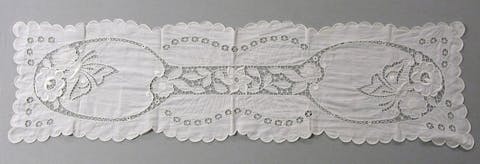
Table runner, white linen with cutwork and mountmellick embroidery. Image: Auckland Museum / License: CC BY 4.0
Another suggestion is to mix 1 tbsp of lemon juice and 2 tbsps of sea salt, formed into paste and apply directly on the spots which should lighten them after about 30 minutes, then you should rinse out the paste. Reapply if necessary. I have not tried this so cannot confirm the results. However, as with most stains you should not rub the paste or cleaning solution into the fabric.It just presses the stain in further. Rinse and wash gently by hand then hang to dry.
Depending on how severe the stains are, one of these methods can help. There are also good commercial green cleaners for delicate textiles.
Conclusion: No, a leopard can't change its spots, but spots on a leopard print table cloth or apron can be removed.
To paraphrase a famous frog, “It's not easy going green”, but we can certainly try to do our best. The techniques and solutions we learned from our older and wiser family members paved the way for today's commercially green products. Natural is always best.
Before you try any hack or tip or advice from an unknown face online, test it first on a tiny spot. Try green products to clean, and if all else fails, think “What would grandma do?”
Submit your treasures for appraisal here and find out what are they worth!
Valerie Hammond has been an antique and vintage jewellery dealer since 1985. She develops courses and does guest speaking across Ontario, Canada, and conducts interactive workshops on antiques and collectables for organisations, clubs and libraries. She is a contributing writer to numerous antique journals, is an online appraiser and supplies props and jewellery for television commercials and film. Val was also the Poet Laureate for the city of North York, Ontario from 1981-83, and the first female Poet Laureate in Canada.

